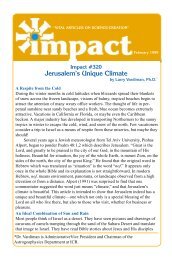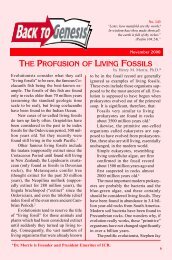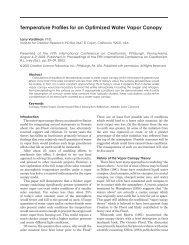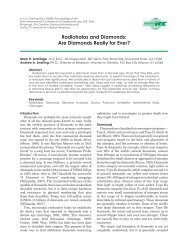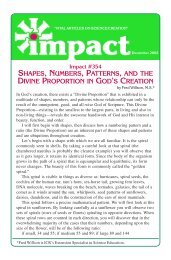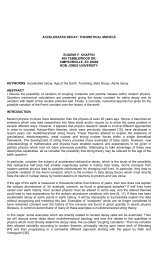Acts & Facts - Institute for Creation Research
Acts & Facts - Institute for Creation Research
Acts & Facts - Institute for Creation Research
Create successful ePaper yourself
Turn your PDF publications into a flip-book with our unique Google optimized e-Paper software.
BACK TO GENESISComplexPlant Systems:%75Rooted inGod’s GeniusFRANK SHERWIN, M.A.There are at least a half-million speciesof plants in the world. Althoughthey do not contain living souls, 1plants nevertheless display incredibledesign features and complex interactions withother plants and insects.Plants have immune systems that seem tobe every bit as biochemically complex as thosein vertebrates. Botanists have discovered that aplant can distinguish a nematode (tiny parasiticroundworm) from a virus, actively resist a penetratingmold, and produce odors to defend itselfagainst a feeding caterpillar. 2 Indeed, the Creatorhas designed plants with chemical detectors thatare precise enough to discern between a beetleand a caterpillar.Plant resistance is a whole new field (soto speak) of botany that has bloomed in recentdecades. Fascinating discoveries include proteinsproduced by plants that are toxic to invadingmicrobes, and toxic soap-like compoundscalled saponins that are designed to resist plantpathogens such as various fungi. Other effectiveanti-fungal chemicals include cysteine-richpeptides called defensins, which are found inpeople as well as plants. This fact does not necessarilyindicate that plants and people camefrom a common ancestor. On the contrary, ifthey had the same Designer, we would expectthat He might have provided them both witheffective fungistats.Far from being inert entities that merelyprovide us with food and aesthetic value, plantscan actively respond to their environments byadjusting their looks and growth—and eventheir behavior, from defensive to aggressive.For instance, plants can wage chemical warfareagainst other plants. In 2003, researchers fromColorado State University found that the rootsof the spotted knapweed produce a natural herbicidecalled catechin that causes nearby plantsto self-destruct. When these plants die due to aspecific series of biochemical reactions causedby the catechin, the spotted knapweed takesover their territory. 3In fact, plants even seem to have a sophisticatedsocial life! One study showed that a wildflowercalled a sea rocket was less competitivewith those of the same species, but more aggressivewith others. The authors state, “Our resultsdemonstrate that plants can discriminate kin incompetitive interactions and indicate that theroot interactions may provide the cue <strong>for</strong> kinrecognition.” 4How do neo-Darwinists respond to suchclear evidence of design? A decade ago, in achapter titled “The New Darwinism,” retiredAustralian evolutionary scientist S. A. Barnettwrote:The trans<strong>for</strong>mations revealed by modernbiology are, however, not directed by anyoverriding agency. Biologists can no longerpresent organisms as the product of an intelligentdesigner. 5This pronouncement is not based on empiricalscience, but upon the author’s naturalisticworldview. He credits natural selection ofmutations as “the only credible explanation.” 6But natural selection is not the powerful mechanismthat its supporters envision. One reason todoubt the neo-Darwinian story is that 80 percentof mutations are so slight that they are invisibleto selection. 7 Also, realistic ratios of beneficialto deleterious mutations hover around 1:1 million.8 There<strong>for</strong>e, the deleterious ones relentlesslyaccumulate, cannot be selected “out,” and eventuallylead to fatal data corruption.Natural selection at most accounts <strong>for</strong>some members of a population surviving ingreater numbers, but it leaves the less <strong>for</strong>tunateones unfit <strong>for</strong> survival. This might lead to extinctionof certain breeds, but not to the inventionof a whole new organism, useful body part,or a single cell, much less the complex biochemicalcommunication systems in plants. There isa more convincing explanation <strong>for</strong> the origin ofplants, with their capacity <strong>for</strong> minor variations,but it would give glory and honor to the Creator,not to His creation.References1. Morris, J. 1991. Are Plants Alive? <strong>Acts</strong> & <strong>Facts</strong>. 20: (9).2. Sherwin, F. 2005. All Out War in the Cornfield. <strong>Acts</strong> & <strong>Facts</strong>.34 (8).3. Bias, H. P. et al. 2003. Allelopathy and Exotic Plant Invasion:From Molecules and Genes to Species Interactions.Science. 301: 1377-1380.4. Dudley, S. and A. File. 2007. Kin recognition in an annualplant. Biology Letters. 3 (4): 435-438.5. Barnett, S. A. 1998. The Science of Life. Australia: Allen &Unwin, 215.6. Ibid, 214.7. Kimura, M. 1979. Model of effectively neutral mutations inwhich selective constraint is incorporated. Procedures of theNational Academy of Science. 76 (7) 3440-3444.8. Gerrish, P. J. and R. E.Lenski. 1998. The fate ofcompeting beneficial mutationsin an asexual population.Genetica. 102/103:127-144.Mr. Sherwin is Senior ScienceLecturer.14 ACTS&FACTS • NOVEMBER 2008



